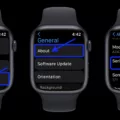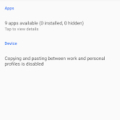App updates are a common occurrence in the world of smartphones. Developers regularly release updates to improve the performance, fix bugs, and introduce new features to their apps. While these updates are generally beneficial, there may be instances where you prefer an older version of an app. The good news is that it is possible to roll back to an older version of an app on Android devices.
To begin the process, open the Settings app on your Android phone. Look for the “Apps & Notifications” option and tap on it. This will lead you to a list of all the apps installed on your device. Scroll through the list and find the system app that you wish to downgrade. Once you locate the app, tap on it to access the Application Info page.
In the top right corner of the Application Info page, you will see a three-dot button. Click on this button to reveal a dropdown menu. From the options available, select “Uninstall updates.” By choosing this option, you are essentially reverting the app back to its original version, eliminating any updates that were installed.
It is important to note that not all apps can be rolled back to older versions. This process is primarily applicable to system apps that came pre-installed on your Android device. Additionally, it is worth mentioning that uninstalling updates for an app will remove any new features or bug fixes that were introduced in the latest update. Therefore, it is crucial to consider the reasons for wanting to roll back an app and weigh the pros and cons before proceeding.
For Windows users, the process of uninstalling updates is slightly different. To uninstall a Windows update, navigate to the Settings app on your computer. From there, select “Update & Security” and then click on “Windows Update.” Next, choose the option “Update history” and locate the specific update you wish to remove. select “Uninstall” next to the update to complete the process.
While app updates are generally beneficial, there may be instances where you prefer an older version of an app. On Android devices, it is possible to roll back to an older version by uninstalling updates for system apps. However, it is important to consider the implications of uninstalling updates, as it may result in the loss of new features and bug fixes. For Windows users, the process of uninstalling updates differs slightly but can also be done through the Settings app.

How Do You Revert to an Older Version of an App?
To revert to an older version of an app on your Android device, follow these steps:
1. Open the Settings app on your phone.
2. Look for the “Apps & Notifications” option and tap on it.
3. You will see a list of all the installed apps on your device. Scroll through the list and find the app you want to revert.
4. Once you find the app, tap on it to open its settings.
5. On the app’s settings page, you should see an option that says “Uninstall updates” or “Manage app updates.” Tap on it.
6. A confirmation message will appear, asking if you want to uninstall updates for the app. Click on “OK” or “Uninstall” to proceed.
7. The app will now be reverted to the version that was originally installed on your device. Any updates or changes made to the app will be removed.
Please note that not all apps can be reverted to older versions, especially if the app developer has disabled this feature. Additionally, reverting to an older version may cause compatibility issues or make the app behave differently. It is always a good idea to backup any important data before reverting to an older version of an app.
Can You Uninstall an App Update?
It is possible to uninstall updates for certain apps on your Android device. However, it should be noted that this feature may not be available for all apps, particularly those that came pre-installed on your device.
To uninstall an app update, you can follow these steps:
1. Go to the Settings menu on your Android device.
2. Scroll down and tap on “Apps” or “Applications” (the exact wording may vary depending on your device).
3. You will see a list of all the apps installed on your device in alphabetical order.
4. Scroll through the list and find the app for which you want to uninstall the update.
5. Tap on the app to open its Application Info page.
6. On the Application Info page, you should see an option called “Uninstall updates” or “Uninstall latest update.” Tap on this option.
Note: If the “Uninstall updates” option is grayed out or not available for the app, it means that you cannot uninstall the update for that particular app.
Uninstalling an app update will revert the app back to its original version, which was pre-installed on your device or the version that came with the last system update. Keep in mind that uninstalling updates may also remove any new features or improvements that were introduced in the update.
If you encounter any issues or are unable to find the “Uninstall updates” option for a specific app, it is recommended to check the app’s settings or consult the device manufacturer’s support documentation for more specific instructions.
While uninstalling app updates can be done for certain apps on certain Android devices, it is important to exercise caution and consider the potential impact of reverting to an older version of the app.
Can You Cancel an Update on an App?
It is possible to cancel or undo an update on an app for Android users. Unlike iPhone users, Android users have the convenience of being able to rollback app updates directly through the device’s settings.
Here is a step-by-step guide on how to undo an app update on an Android device:
1. Open the “Settings” app on your Android device. This can typically be found in the app drawer or by swiping down from the top of the screen and tapping on the gear icon.
2. Scroll down and select “Apps” or “Applications” from the list of available options. The exact wording may vary depending on the device and Android version.
3. In the “Apps” or “Applications” menu, you will see a list of all the apps installed on your device. Locate the app for which you want to undo the update and tap on it.
4. On the app’s information page, you will see several options, including “Force Stop,” “Uninstall,” and “Disable.” Look for the three-dot menu icon (usually located in the top-right corner) and tap on it.
5. From the dropdown menu, select “Uninstall updates” or a similar option. This will remove the latest update and revert the app to its previous version.
6. A confirmation pop-up may appear asking if you want to uninstall updates. Tap “OK” to proceed.
7. Once the update has been uninstalled, you will have successfully rolled back the app to its previous version.
It’s important to note that not all apps will allow you to uninstall updates. System apps and certain pre-installed apps may not have this option available.
In case the option to uninstall updates is not available for a particular app, you can try clearing the app’s data and cache. This can be done by going to the app’s information page (following steps 1-3 above) and tapping on the “Storage” or “Storage & cache” option. From there, you can clear the app’s data and cache, which may help resolve any issues caused by the update.
Please keep in mind that undoing an app update means that you will lose any new features, bug fixes, or security improvements that the update may have brought. It’s recommended to only rollback updates if you are experiencing issues or compatibility problems with the latest version of the app.
Conclusion
App updates on Android devices can be rolled back to older versions if necessary. This can be done by accessing the Settings app on your phone, tapping on Apps & Notifications, and selecting the app you wish to downgrade. From there, you can click on the three-dot button in the top right corner and choose to uninstall updates. This will revert the app back to its previous version.
On the other hand, Windows updates can also be uninstalled on a PC. By going to the Start menu, selecting Settings, and then navigating to Windows Update and Update history, you can view a list of installed updates. From there, you can select the update you want to remove and click on Uninstall next to it.
It’s important to note that not all apps on Android devices can have their updates uninstalled. This option is typically available for system apps or pre-installed apps. Additionally, it is easier to roll back Android updates compared to iPhone updates, as the uninstallation process can be done directly in the device’s Settings.
The ability to roll back app updates can be useful in situations where a newer version of an app is causing issues or is not preferred. With the steps outlined above, users can easily revert to a previous version and continue using the app without the problems associated with the update.













